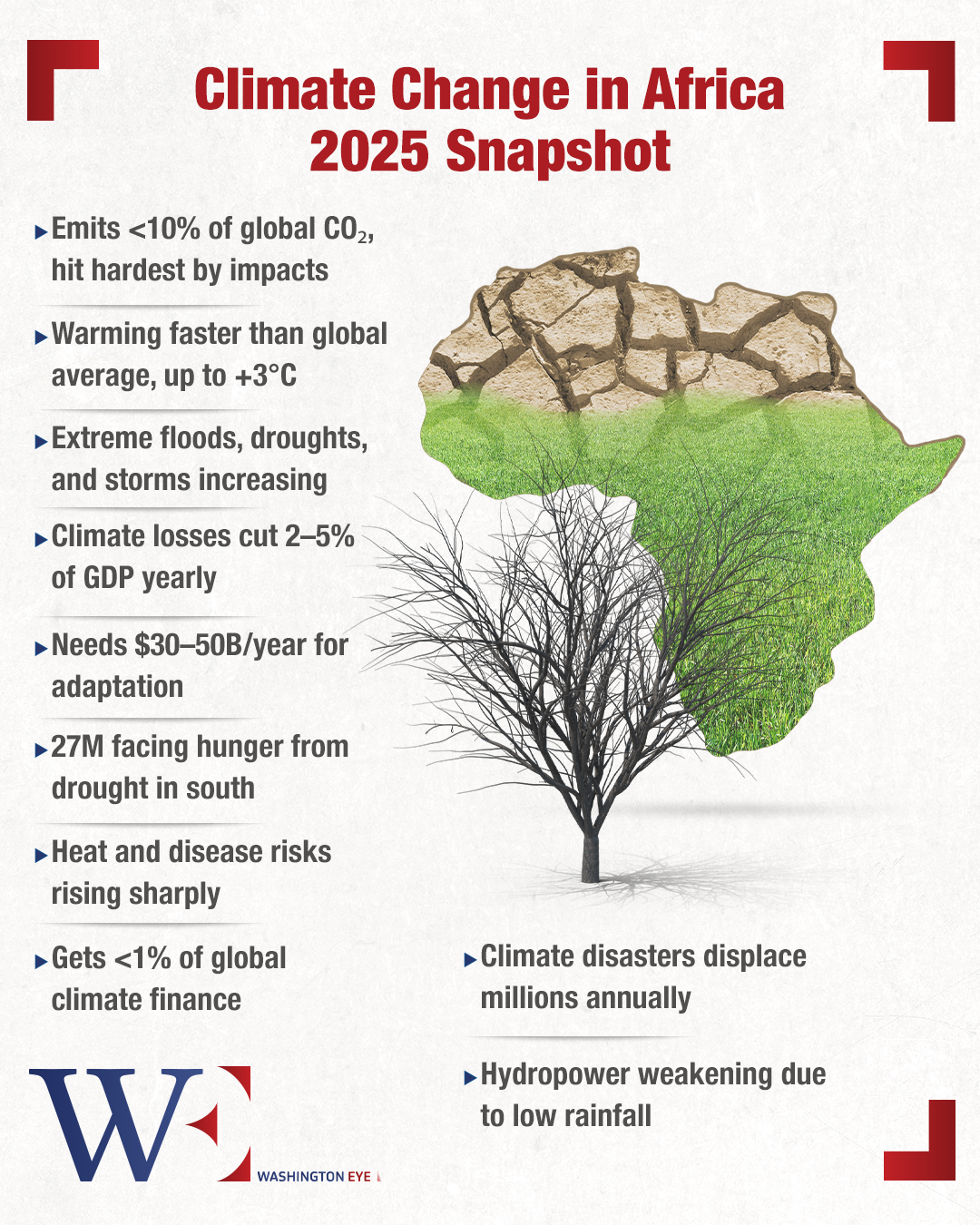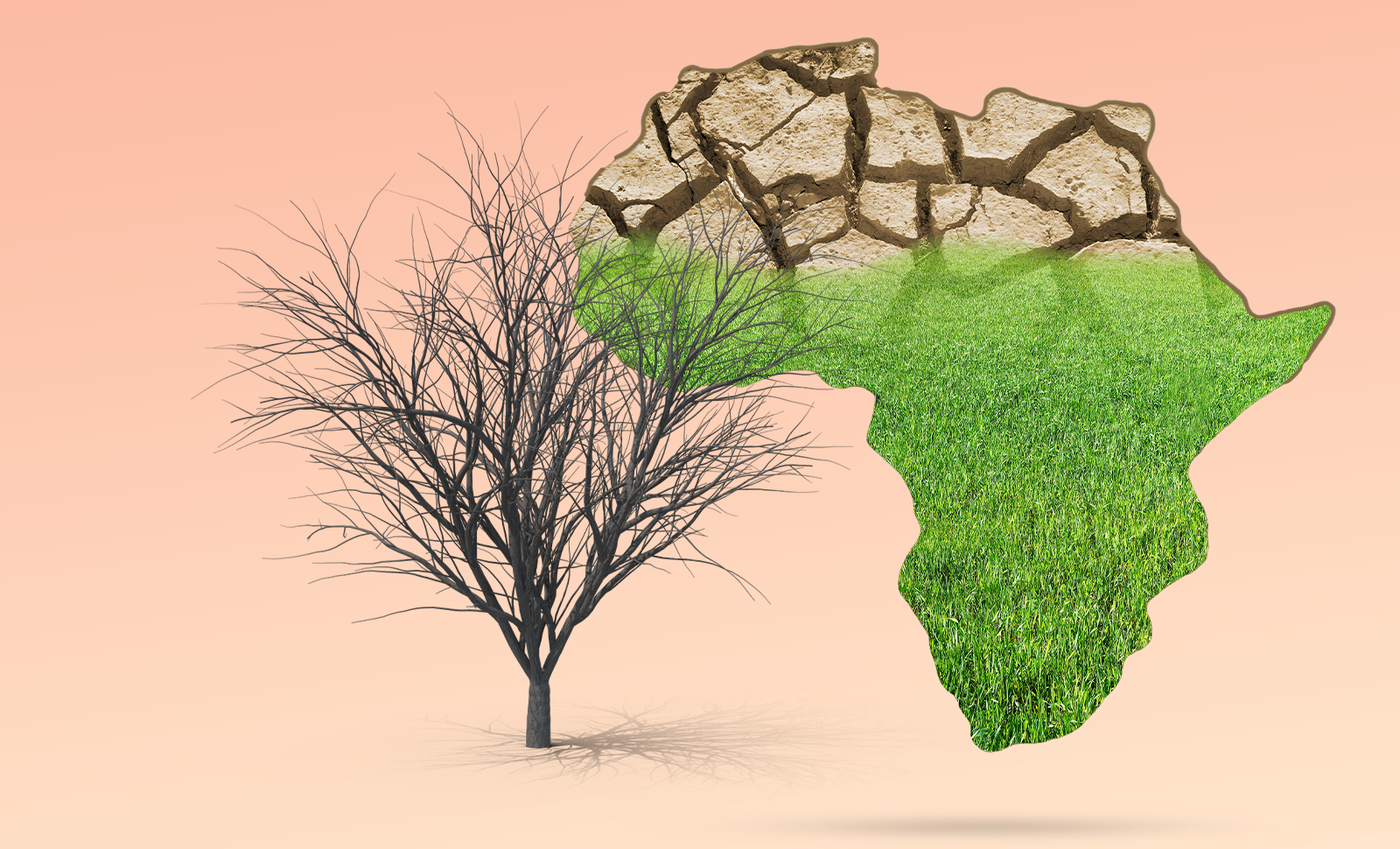Africa, a continent with immense cultural, ecological, and economic diversity, is at a critical juncture. As climate change intensifies, its cascading effects threaten to upend lives, food systems, economies, and public health across the region. This isn’t just a looming crisis — it’s already here. The question now is: how long can Africa withstand the environmental and human pressure?
Climate Change and Africa’s Fragile Foundations
The Intergovernmental Panel on Climate Change (IPCC) has long classified Africa as one of the most vulnerable continents to climate change due to the interplay of environmental and socioeconomic stressors. Africa’s dependence on rain-fed agriculture — which contributes over 90% of food production in sub-Saharan regions — leaves millions exposed to erratic rainfall and shifting weather patterns. Projected climate shifts could lead to a 50% reduction in rain-fed agricultural productivity by 2080, potentially pushing tens of millions further into hunger and poverty, according to UNFCCC.
Agriculture, Food Security, and Water Scarcity
Africa’s agricultural backbone is under siege. In the Sahel region, for instance, desertification is rapidly advancing, transforming fertile land into unusable terrain. This is already evident in countries like Ethiopia, Sudan, and Chad, where declining soil quality and rainfall are leading to decreased crop yields and growing food insecurity. In contrast, East African countries such as Kenya, Uganda, and South Sudan are experiencing increased rainfall and devastating floods that displace communities and destroy infrastructure, according to ReliefWeb.
Meanwhile, southern and western Africa are contending with worsening water scarcity as rivers and aquifers continue to dry up. In many regions, clean drinking water is becoming increasingly inaccessible, especially in rural areas. Ironically, while some areas are experiencing drought, others suffer from flooding that contaminates water sources and fosters the spread of disease. These opposing water crises underscore the complex hydrological challenges the continent faces.
Coastal Erosion and the Crumbling Tourism Sector
Climate change is also wreaking havoc along Africa’s coasts. Countries such as Mozambique, Senegal, Nigeria, and Tanzania are witnessing the effects of rising sea levels, which threaten not only their environments but also economically vital sectors like tourism. The erosion of coastlines, the intrusion of saltwater into freshwater systems, and the degradation of marine ecosystems are not only displacing people but also threatening infrastructure and long-standing industries, according to a UNEP Coastal Erosion Study.
Popular tourist destinations like Zanzibar and Cape Verde, previously known for their pristine beaches and scenic coastlines, are now facing declining tourist numbers as beach erosion and climate vulnerability grow. For many coastal communities, this translates to job losses, diminished public revenue, and weakened resilience against future shocks.
Health: A Silent Casualty of a Changing Climate
Beyond the visible environmental and economic damage, the climate crisis is also unfolding as a significant public health emergency. Rising temperatures and unstable weather are creating ideal conditions for the spread of climate-sensitive diseases. Historical events like the 1997/98 El Niño episode were linked to widespread outbreaks of malaria, cholera, and Rift Valley fever in East Africa. Today, similar patterns are emerging with increasing frequency and scale.
In the Sahel belt, dry and dusty conditions are contributing to seasonal spikes in meningitis, while elsewhere, stagnant floodwaters are breeding grounds for cholera and dengue. The toll is especially heavy on children, the elderly, and individuals with compromised immune systems, including those living with HIV/AIDS. As health systems in many African countries remain underfunded and overstretched, the rising health burden adds a layer of urgency to the climate conversation, according to a WHO Africa Climate Factsheet.
Most Affected Countries: The Climate Hotspots
Across the continent, certain countries have emerged as the epicenters of climate impacts. Mozambique, for example, has endured repeated cyclones in recent years, most notably Cyclone Freddy in 2023, which caused widespread destruction and displacements. In Ethiopia, prolonged droughts in southern regions have devastated crops and water supplies, contributing to growing humanitarian needs.
Sudan and South Sudan are experiencing both extremes of the climate spectrum — severe droughts in some regions and extreme flooding in others. Kenya, on the other hand, is grappling with unpredictable rainfall patterns that wreak havoc on farming cycles and water access. Nigeria’s densely populated coastal city of Lagos faces the dual threat of sea-level rise and heavy rains, endangering infrastructure and livelihoods. Zimbabwe, too, continues to experience increasingly erratic rainfall and frequent droughts, which hinder agricultural planning and hurt already fragile rural economies.
Adaptation: What’s Being Done?
Despite the severity of these challenges, many African countries are taking active steps to adapt and build resilience. Since the 1992 Earth Summit, African nations have introduced a range of adaptation strategies. These include the development of drought-resistant crop varieties, the expansion of agroforestry systems to improve soil fertility, and the implementation of integrated pest management techniques. Additionally, climate-smart agriculture — which focuses on sustainable, adaptive, and productive farming methods — is gaining traction across the continent.
Governments and communities are also investing in early warning systems to better prepare for extreme weather, as well as water harvesting technologies and solar-powered irrigation systems to maximize scarce water resources. These efforts are bolstered by large-scale initiatives such as the Africa Adaptation Acceleration Program (AAAP), which aims to mobilize $25 billion by 2025 to enhance adaptation capacity across the continent. However, these programs face a massive funding gap. According to the Climate Policy Initiative, Africa needs upwards of $100 billion annually in climate financing, but current flows remain well below that target.
A Final Note: At the Edge of a Tipping Point
So, will climate change break Africa’s back? The answer depends on the world’s commitment to solidarity and urgent action. Africa has already demonstrated resilience, innovation, and a willingness to confront the climate crisis head-on. However, the continent cannot — and should not — be expected to navigate these challenges alone.
Without robust international support, equitable climate financing, and a serious global effort to reduce emissions, Africa will face mounting pressures that could destabilize entire regions. Preventing this outcome isn’t just a matter of justice — it’s a global imperative, what happens in Africa will reverberate far beyond its borders.


















